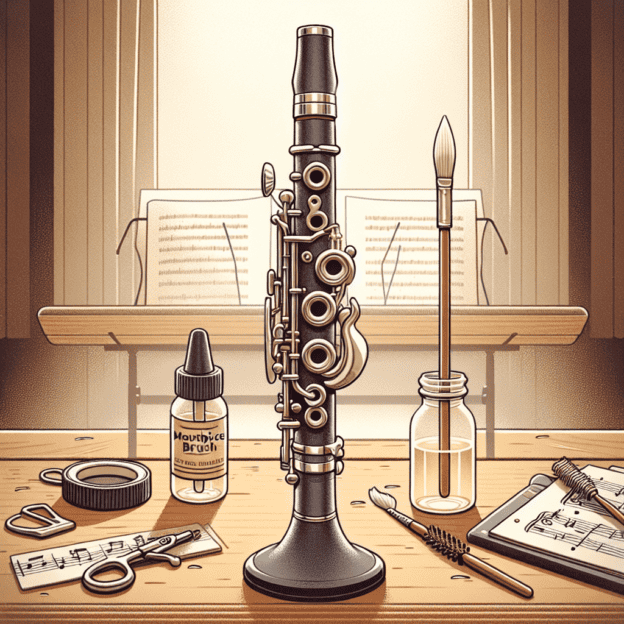The clarinet mouthpiece, often underestimated, plays an important role in shaping your instrument's sound. Whether you're just starting out or have years of experience, grasping the nuances of your mouthpiece can dramatically enhance your musical journey. Let's explore how to choose the perfect mouthpiece, and uncover tips for maintaining it in prime condition.
What is a Clarinet Mouthpiece?
The clarinet mouthpiece is where the magic begins. It's the component where you position your reed and channel air to create sound. The mouthpiece's design and quality significantly impact your tone, intonation, and overall sound quality. A well-suited mouthpiece can transform your playing experience, making practice sessions more rewarding and enjoyable.
The Anatomy of a Mouthpiece
To truly appreciate a mouthpiece's role in sound production, it's important to understand its key components:
| Component | Description | Impact on Sound |
|---|---|---|
| Tip Opening | The gap between the mouthpiece tip and the reed | Wider openings allow more airflow, creating a fuller sound |
| Facing Length | The distance from the tip to where the reed rests | Affects response time; shorter facings often yield quicker responses |
| Table | The flat surface where the reed sits | Ensures proper reed vibration for optimal sound production |
| Side Rails | The sides of the mouthpiece control airflow | Thickness variations affect tonal quality and flexibility |
Types of Clarinet Mouthpieces
When it comes to mouthpieces, there's no one-size-fits-all solution. Here are the main categories:
- Student Mouthpieces: Designed for beginners, these prioritize ease of play and help develop proper embouchure and tone without excessive resistance.
- Intermediate Mouthpieces: As players progress, they often seek mouthpieces that balance ease of use with improved tonal quality. Brands like Martin Freres offer excellent options in this category.
- Professional Mouthpieces: Crafted for advanced players, these mouthpieces allow for a wide range of tonal colors and dynamic expression. The choice often boils down to personal preference and playing style.
Choosing the Right Mouthpiece
Selecting the perfect mouthpiece is a personal journey. Consider these factors:
- Playing Style: Do you lean towards jazz, classical, or contemporary music? Different genres may require specific mouthpiece characteristics.
- Skill Level: As you advance, your mouthpiece needs may change. Be open to exploring new options that support your musical growth.
- Reed Selection: The thickness and material of your reed interact with your mouthpiece. Generally, thicker reeds pair well with mouthpieces featuring wider tip openings.
Testing and Trying Mouthpieces
The most effective way to find your ideal mouthpiece is through trial and error. Visit a music store where you can test various options. Many stores carry mouthpieces from reputable brands, including Martin Freres, allowing you to find the perfect match for your clarinet.
Caring for Your Mouthpiece
Proper maintenance is necessary for optimal mouthpiece performance. Follow these care tips:
Mouthpiece Maintenance Routine
- Daily Cleaning: After each use, remove the reed and rinse your mouthpiece with lukewarm water. Use a mouthpiece brush to clean the interior, preventing buildup from saliva or debris.
- Weekly Deep Clean: Soak your mouthpiece in a mild soap solution for about 15 minutes to remove stubborn grime. Rinse thoroughly and allow it to air dry.
- Monthly Inspection: Regularly check for signs of wear or damage, such as small cracks or chips.
Common Mouthpiece Issues
Even with diligent care, you may encounter issues. Here's how to address them:
- Cracks: Small cracks can significantly alter your tone. If you notice any, consider replacing the mouthpiece.
- Alignment Problems: Ensure the reed is properly aligned on the mouthpiece table. Misalignment can cause unwanted squeaks and poor sound quality.
- Wear and Tear: Regularly inspect your mouthpiece for signs of wear. A mouthpiece showing significant wear may not perform optimally.
Professional Help
Every clarinet player can benefit from professional advice at some point. Experts can provide tailored guidance on your instrument and playing style, including how the mouthpiece affects your sound. Reputable brands like Martin Freres often stress the importance of regular maintenance and playability adjustments.
Understanding your clarinet mouthpiece is key to achieving your best sound. As you explore different options, focus on finding a mouthpiece that complements your unique style and needs. Regular cleaning, experimenting with new mouthpieces, and seeking expert advice will elevate your playing experience, leading to more enjoyable and productive practice sessions.







